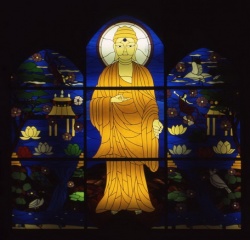Dhatu
Dhātu: 'elements', are the ultimate constituents of a whole.
I The 4 physical elements dhātu or mahā-bhūta popularly called earth, water, fire and wind, are to be understood as the primary qualities of matter. They are named in Pāli: pathavī-dhātu, āpo-dhātu, tejo-dhātu, and vāyo-dhātu In Vis.M XI, 2 the four elements are defined thus:,Whatever is characterized by hardness thaddha-lakkkhana is the earth or solid-element; by cohesion ābandhana or fluidity, the water-element; by heating paripācana the fire or heat-element; by strengthening or supporting vitthambhana the wind or motion-element. All four are present in every material object, though in varying degrees of strength. If, for instance, the earth element predominates, the material object is called 'solid', etc
earth element; thaddha-lakkkhana
water-element
air element
fire element
I The 4 physical elements dhātu or mahā-bhūta popularly called earth, water, fire and wind, are to be understood as the primary qualities of matter.
They are named in Pāli:
pathavī-dhātu,
āpo-dhātu,
tejo-dhātu, and
vāyo-dhātu
In Vis.M XI, 2 the four elements are defined thus: ,Whatever is characterized by hardness thaddha-lakkkhana is the earth or solid-element; by cohesion ābandhana or fluidity, the water-element; by heating paripācana the fire or heat-element; by strengthening or supporting vitthambhana the wind or motion-element. All four are present in every material object, though in varying degrees of strength. If, for instance, the earth element predominates, the material object is called 'solid', etc. - For the analysis of the 4 elements,
see: dhātu-vavatthāna
II The 18 physical and mental elements that constitute the conditions or foundations of the process of perception, are:
1. visual organ eye
2. auditory organ ear
3. olfactory organ nose
4. gustatory organ tongue
5. tactile organ body
6. visible object
7. sound or audible object
8. odour or olfactive object
9. gustative object
10. body-contact
11. visual-consciousness
12. ear-consciousness
13. nose-consciousness
14. tongue-consciousness
15. body-consciousness
16. mind-element mano-dhātu
17. mental-object dhamma-dhātu
18. mind-consciousness-element mano-viññāna-dhātu
